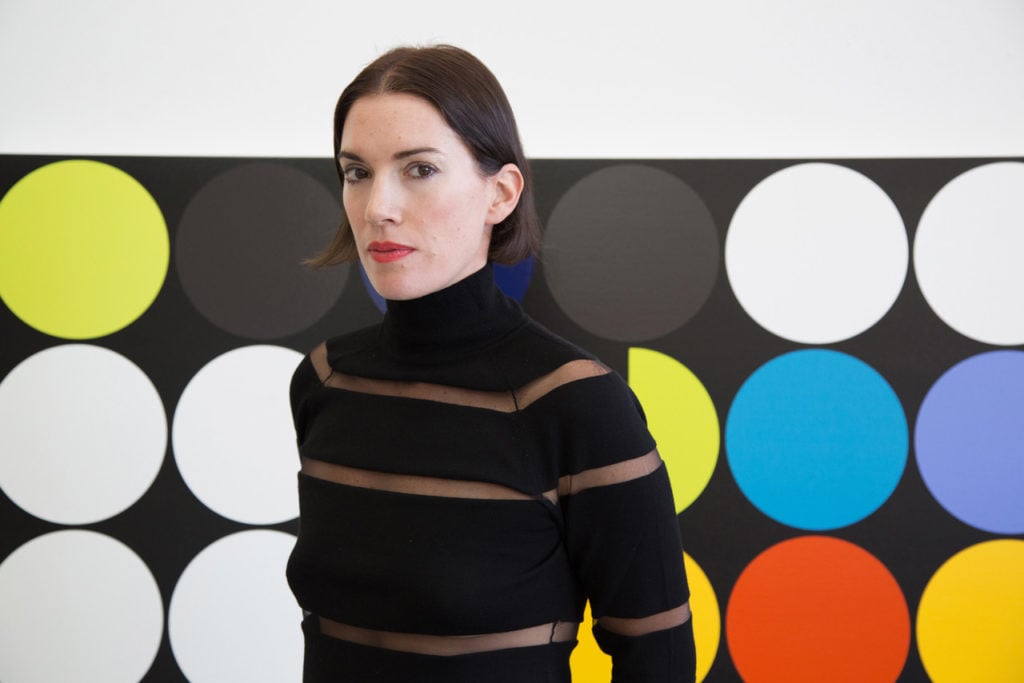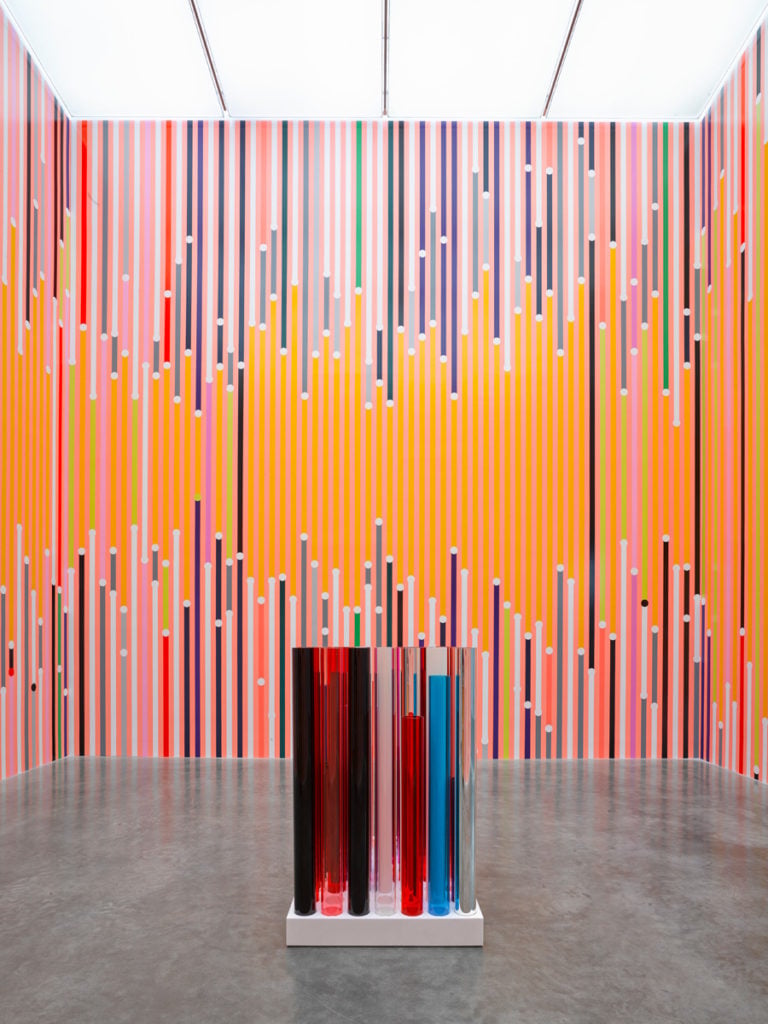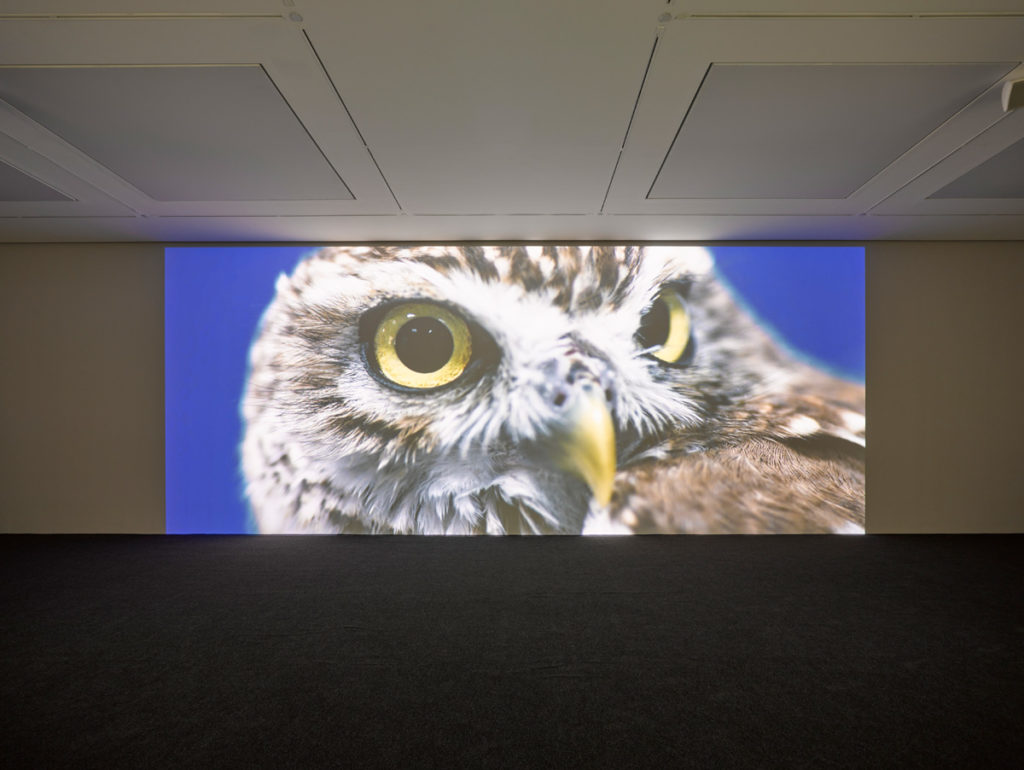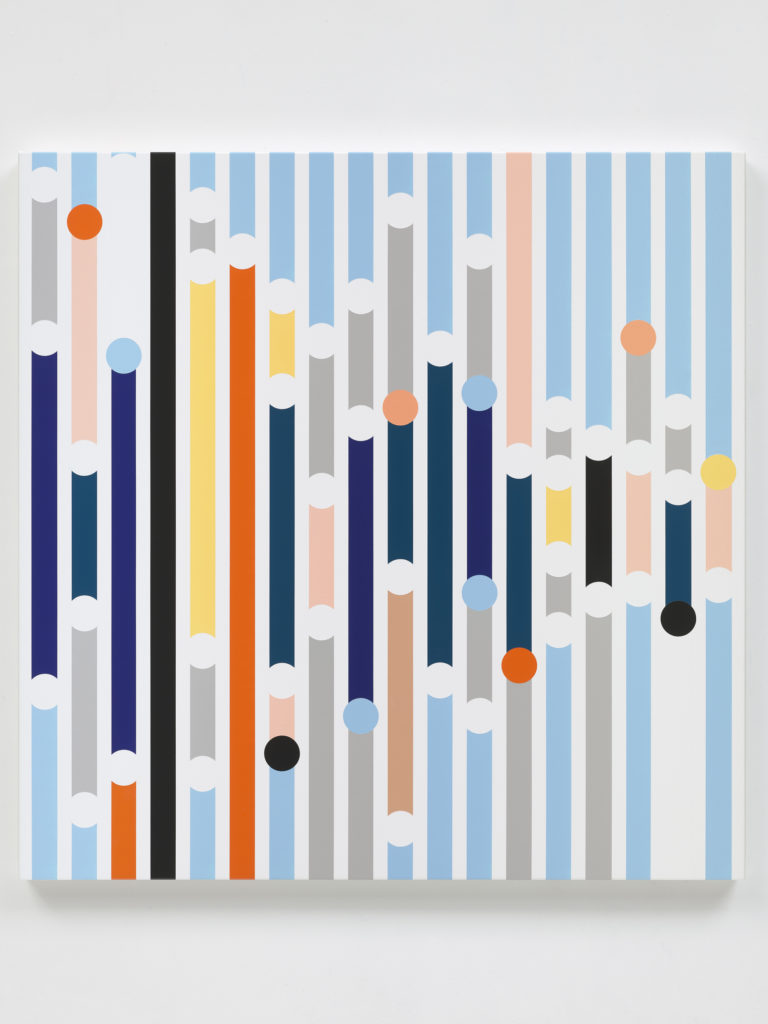People
‘I View All Space as Public’: Sarah Morris Explains Why Nothing Is Off Limits in Her New Paintings and Films
The artist's current show at White Cube in London is her first UK exhibition in six years.

The artist's current show at White Cube in London is her first UK exhibition in six years.

Taylor Dafoe

There’s a tension at the heart of artist Sarah Morris’s work that at times seems unresolvable. On one hand, her conceptually rigorous paintings are made in dialogue with the work of Frank Stella and contemporary design. On the other, her dense, expressionistic film essays focus on specific times and places, such as Beijing in the lead up to the 2008 Olympics. There are thematic similarities between the two bodies of work—an emphasis on architecture and urban environments, for example—but even then, the link can seem tenuous. Morris’s current show, “Machines do not make us into Machines” at White Cube in London, captures the tension well. The show brings together a new batch of what she calls “Sound Graphs”—large-scale paintings based on personal audio recordings—with two films. While one focuses on Abu Dhabi (a utopia and dystopia, according to the artist), the other, titled Finite and Infinite Games (2017), moves across topics, from Herzog & de Meuron’s new concert hall in Hamburg to a meditation on the role of the artist. Named after the novel by James P. Carse—a cult text cited equally in philosophy and number theory classes—the film is narrated by German writer and director Alexander Kluge. On the occasion of the exhibition, artnet News visited the artist in her Long Island City studio to learn about how it all fits together..
![Sarah Morris, <i>Deviancy is the Essence [Sound Graph]</i> (2018). © Sarah Morris. Photo: Tom Powel Imaging. Courtesy of White Cube.](https://news.artnet.com/app/news-upload/2019/05/Sarah-Morris-Deviancy-is-the-Essence-Sound-Graph-2019-medium-res-809x1024.jpg)
Sarah Morris, Deviancy is the Essence [Sound Graph] (2018). © Sarah Morris. Photo: Tom Powel Imaging. Courtesy of White Cube.
Tell me about your “Sound Graph” paintings. Where did that idea come from? I’d always had in my mind this idea for a series of paintings based on language, speech, and text. In some ways, you could look at all of my work as an exercise in streamlining into images. For these works, I used elements of personal audio files I have, which I record all the time. They’re conversations with people, snippets of different sounds, etc. One of the first pieces I ever did, for instance, was based on a recording of a police radio in New York City. The recording told all these broken narratives of a woman on 14th street who lost a bag. I love the idea that all of these interrupted narratives that you see in the city are constantly unfolding. You don’t know the beginning and don’t know the end; they’re just sort of transpiring all the time, and you have no idea really what they necessarily mean. They just weave in and out. I like that description. That’s how I would describe much of your painting and film work as well. It’s very open. When I first made the film Midtown in 1998, that’s what I was trying to do: to make a manifesto for the paintings that would simultaneously take control of the references in my work and render this open system of coordinates. You know, you’re at Chase Bank, you’re at Port Authority, you’re at Penn Station or the Seagram Building. That’s what “Midtown” is—a series of coordinates that refer to very specific points. My films usually comprise a list of places. Sometimes those places become the titles of paintings, sometimes they don’t. Both things sort of inform each other; it goes back and forth.

An installation view of Sarah Morris’s show, “Machines do not make us into Machines,” at White Cube Bermondsey. Courtesy of White Cube. Photo: Ollie Hammick.
I’ve always been curious about the relationship between your paintings and your films, especially when they’re shown together, as they are in your current White Cube show. Looking at Finite and Infinite Games in particular, the film has thematic similarities with the “Sound Graph” paintings, but the connection is subtle. People always want to know which comes first, the paintings or the films. For me, it’s not about which comes first. It’s all going on at the same time. Today, for instance, we’re working on a budget for a new film in Asia that we need to send off to somebody who knows the day rates in that country. I’m putting together a proposal for a public project. And paintings are always going on. There’s a lot of different things happening. What’s the dynamic between the films and the paintings? All I can tell you is it’s always all going on at the same time. I don’t know if you can make a linear, causal connection, but there is obviously a link. There are linguistic connections between the titles. There are connections in terms of color and composition. And rhythm too—all of the films have this sort of relentless quality to them that’s slightly hypnotic. You can even look at the films as a study. On the other hand, sometimes we’ll do research for paintings and compositions for paintings, and it will lead me to a very specific space. The conversation goes both ways. The paintings often reference specific locations, buildings, and cities, but the imagery is abstracted and aestheticized, so that there’s a tension there. Is that how you feel about it too? For me, the paintings are not depictions of space, although you could possibly view them as that. They become some other form of space. They’re not virtual space, because a painting is a built thing, obviously. I subscribe to that Frank Stella notion that what you see is what you see. That said, I try to incorporate elements of the films into the paintings, usually through composition, the titles, or even the use of certain colors—I often play with the psychology of colors. I view all space as public, in a sense. All space should be available to the artist, or all space can be co-opted by an artist. There’s really nothing that’s off limits to the work in terms of subject matter. Earlier on, people thought that I was just making figurative paintings of these places. Obviously not. I could see it, but I don’t think of it that way—and I didn’t back then. It’s not indexical. It’s not a photograph, it’s a painting.

An installation view of Sarah Morris’s show, “Machines do not make us into Machines,” at White Cube Bermondsey. Courtesy of White Cube. Photo: Ollie Hammick.
If you’re making a painting that deals with real-life subject matter, why abstract it? Why not make it more indexical or figurative? I always wanted to resist that. I think painting should somehow try to make a new space, a space that doesn’t exist already. I’m not really interested in mimicking what already exists. I want to map what is going on, these situations we find ourselves in—both physically and philosophically. For instance, the “Sound Graph” paintings are as much about visual distraction as they are the recordings of they’re based on. The eye is constantly pulsing, constantly moving around. It’s distracted—and I am, too. I think we all are. The eye is constantly trying to make sense of what you’re encountering perceptually. So the paintings are as much about visual perception as they are about audio, because there is this element of distraction and movement and the idea of a painting that can splinter and become another painting. And then it’s sort of self-generating. There’s also a large, site-specific mural in the show. It’s called Ataraxia, a word I had to look up. What does that word mean to you and how does it inform the painting? That’s a word that Kluge uses in the film. He describes it to me when I ask him why, after World War II, he had to leave the Frankfurt School and go to America. I asked him if, later, he came back with any type of resentment. “That’s a really interesting question,” he said, and explained to me a term called “ataraxia.” He described it as an imperturbable calm. It’s a state of mind; generals wanted to send warriors out into the field with this state because they can do more. I really loved the term and started thinking about it. It seemed like an interesting conundrum with the paintings, in particular. They have a lot of noise going on in them, but actually, in the end, it’s sort of like there’s a process going on. They’re system-based on some level, and there’s a level of resolve there.

Sarah Morris, The Building looks like a ship (2019). © Sarah Morris. Courtesy of White Cube. Photo: Tom Powel Imaging.
There’s a glass sculpture in the show as well—your first ever proper sculpture in a gallery setting. Given your interest in space, architecture, and abstraction, sculpture sees like such a natural avenue for you. I was surprised to learn that this was the first time you were properly exploring it. Well, I’ve thought about making sculpture for a long time now. I’ve had conversations with people for years. Only when I found the right fabricator did I think of doing it. You’ve also done several public projects in recent years, including work on an underground tube station in London and at the Federal Courthouse of Bergen in Norway. Then there’s a permanent glass installation in Long Island City, not far from your studio. Is public art something you’re more interested in now than you were before? I find doing projects in the public realm really interesting. I don’t want to do them too often, but they’re interesting. It used to be that there was almost a stigma to the idea of public art, but more and more I think the pendulum is swinging the other way and artists are coming around to the idea again. At this point, to keep your work contained within an insular gallery system and not do work in public is more curious. Why would you not want to have that platform? “Sarah Morris: Machines do not make us into Machines” is on view at White Cube Bermondsey through June 30, 2019.